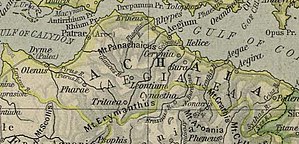
Aetolia is a mountainous region of Greece on the north coast of the Gulf of Corinth, forming the eastern part of the modern regional unit of Aetolia-Acarnania.
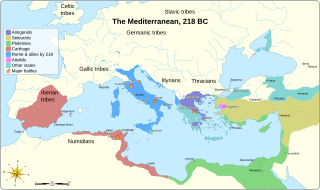
The First Macedonian War was fought by Rome, allied with the Aetolian League and Attalus I of Pergamon, against Philip V of Macedon, contemporaneously with the Second Punic War against Carthage. There were no decisive engagements, and the war ended in a stalemate.

Cleomenes III was one of the two kings of Sparta from 235 to 222 BC. He was a member of the Agiad dynasty and succeeded his father, Leonidas II. He is known for his attempts to reform the Spartan state.
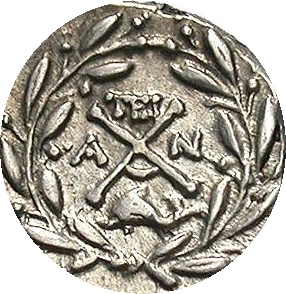
The Achaean League was a Hellenistic-era confederation of Greek city states on the northern and central Peloponnese. The league was named after the region of Achaea in the northwestern Peloponnese, which formed its original core. The first league was formed in the fifth century BC. The second Achaean League was established in 280 BC. As a rival of Antigonid Macedon and an ally of Rome, the league played a major role in the expansion of the Roman Republic into Greece. This process eventually led to the League's conquest and dissolution by the Romans in 146 BC.
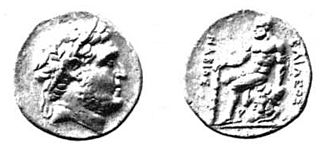
Nabis was the last king of independent Sparta. He was probably a member of the Heracleidae, and he ruled from 207 BC to 192 BC, during the years of the First and Second Macedonian Wars and the eponymous "War against Nabis", i.e. against him. After taking the throne by executing two claimants, he began rebuilding Sparta's power. During the Second Macedonian War, Nabis sided with King Philip V of Macedon and in return he received the city of Argos. However, when the war began to turn against the Macedonians, he defected to Rome. After the war, the Romans, urged by the Achaean League, attacked Nabis and defeated him. He then was assassinated in 192 BC by the Aetolian League. He represented the last phase of Sparta's reformist period.

Hellenistic Greece is the historical period of the country following Classical Greece, between the death of Alexander the Great in 323 BC and the annexation of the classical Greek Achaean League heartlands by the Roman Republic. This culminated at the Battle of Corinth in 146 BC, a crushing Roman victory in the Peloponnese that led to the destruction of Corinth and ushered in the period of Roman Greece. Hellenistic Greece's definitive end was with the Battle of Actium in 31 BC, when the future emperor Augustus defeated Greek Ptolemaic queen Cleopatra VII and Mark Antony, the next year taking over Alexandria, the last great center of Hellenistic Greece.

The AetolianLeague was a confederation of tribal communities and cities in ancient Greece centered in Aetolia in Central Greece. It was probably established during the early Hellenistic era, in opposition to Macedon and the Achaean League. Two annual meetings were held at Thermika and Panaetolika. The league occupied Delphi from 290 BC and steadily gained territory until, by the end of the 3rd century BC, it controlled the whole of central Greece with the exception of Attica and Boeotia. At its peak, the league's territory included Locris, Malis, Dolopes, parts of Thessaly, Phocis, and Acarnania. In the latter part of its power, certain Greek city-states joined the Aetolian League such as the Arcadian cities of Mantineia, Tegea, Phigalia and Kydonia on Crete.

Philopoemen was a skilled Greek general and statesman, who was Achaean strategos on eight occasions.
Demetrius of Pharos was a ruler of Pharos involved in the First Illyrian War, after which he ruled a portion of the Illyrian Adriatic coast on behalf of the Romans, as a client king.
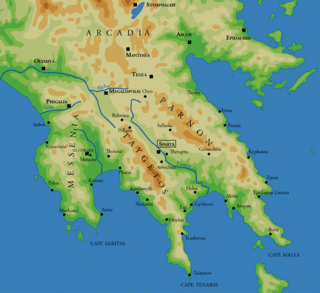
The Battle of Sellasia took place during the summer of 222 BC between Macedon and the Achaean League, led by Antigonus III Doson, and Sparta under the command of King Cleomenes III. The battle was fought at Sellasia on the northern frontier of Laconia and ended in a Macedonian-Achaean victory.

Aratus of Sicyon was a politician and military commander of Hellenistic Greece. He was elected strategos of the Achaean League 17 times, leading the League through numerous military campaigns including the Cleomenean War and the Social War.
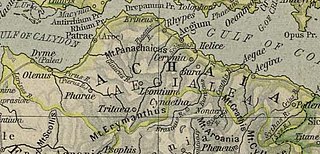
The Battle of Dyme or Dymae was a battle that was fought by the Achaean League under the command of their Strategos, Hyperbatas, and a Spartan army under the command of King Cleomenes III, and was part of the Cleomenean War. The battle took in place near Dyme in north-west Achaea and was fought in 226 BC.
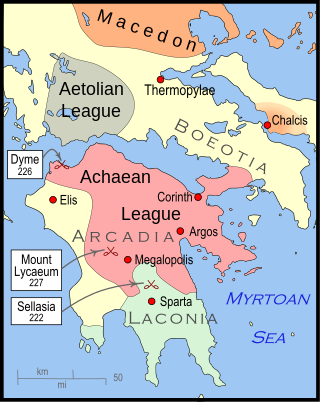
The Cleomenean War was fought between Sparta and the Achaean League for the control of the Peloponnese. Under the leadership of king Cleomenes III, Sparta initially had the upper hand, which forced the Achaean League to call for help the Macedonian king Antigonos Doson, who decisively defeated Cleomenes in the battle of Sellasia in 222.

The Social War, also War of the Allies and the Aetolian War, was fought from 220 BC to 217 BC between the Hellenic League under Philip V of Macedon and the Aetolian League, Sparta and Elis. It was ended with the Peace of Naupactus.
Pyrrhias was an Aetolian general, who was sent by his countrymen during the Social War, to take the command in Elis. Here he took advantage of the absence of Philip V of Macedon, and the incapacity of Eperatus the Achaean strategos, to make frequent incursions into the Achaean territories. Having established a fortified post on Mount Panachaikon, he laid waste the whole country as far as Rhion and Aigion. The next year he concerted a plan with Lycurgus, king of Sparta, for the invasion of Messenia. However, he failed in the execution of his part of the scheme, being repulsed by the Cyparissians before he could effect a junction with Lycurgus. In consequence he returned to Elis, but as the Eleans were dissatisfied with his conduct, he was shortly after recalled by the Aetolians and replaced by Euripidas. At a later period he obtained the office of strategos of the Aetolians, in the same year that this office was bestowed as an honorary title upon Attalus I, king of Pergamon. In the spring of that year he advanced with an army to Lamia to oppose the passage of Philip V of Macedon towards the Peloponnese. Though supported with an auxiliary force both by Attalus and by the Roman praetor Publius Sulpicius Galba Maximus, he was defeated by Philip in two successive battles and forced to retire within the walls of Lamia. It is not improbable that Sipyrrhicas, who appears in Livy (XXXI.46) as chief of the Aetolian deputation which met Attalus at Heracleia, is only a false reading for Pyrrhias.
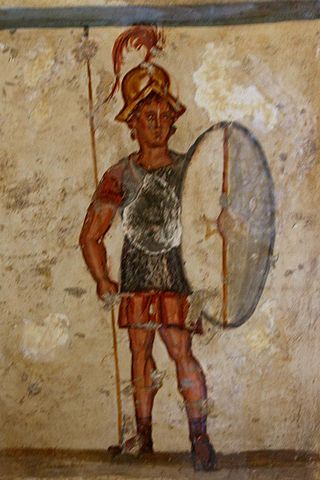
The Antigonid Macedonian army was the army that evolved from the ancient Greek kingdom of Macedonia in the period when it was ruled by the Antigonid dynasty from 276 BC to 168 BC. It was seen as one of the principal Hellenistic fighting forces until its ultimate defeat at Roman hands at the Battle of Pydna in 168 BC. However, there was a brief resurgence in 150-148 during the revolt of Andriscus, a supposed heir to Perseus.

The Battle of Mount Lycaeum was a battle fought between Sparta led by Cleomenes III and the Achaean League commanded by Aratus. It was the first major battle of the Cleomenean War. The battle occurred at Mount Lycaeum on the border of Elis and Arcadia and ended in a Spartan victory.

The Battle of Paxos was a naval battle between a coalition of Illyrian federation with their Acarnanian allies, against the allies of Corcyra, the Achaean League and Aetolian League. The battle took place in the spring of 229 BC and was a direct consequence to the siege of Corcyra by the forces of queen Teuta.

The Lyttian War was an internal conflict fought from around 220 BC to about 216 BC between two coalitions of Cretan city-states, led by Cnossus and Polyrrhenia respectively. The events of the war are recorded by the historian Polybius. It is considered "the greatest war in Cretan history" during Antiquity.
Gnaeus Octavius was a Roman politician and general who served as consul in 165 BC and was the builder of the Porticus Octavia.
